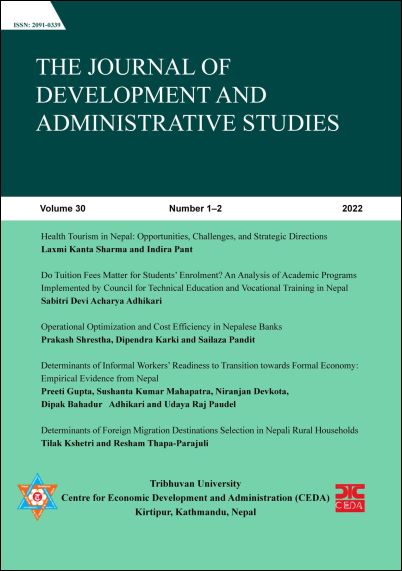Operational Optimization and Cost Efficiency in Nepalese Banks
DOI:
https://doi.org/10.3126/jodas.v30i1-2.69525Keywords:
Panel Data, Capital Adequacy, Credit Risk, Net Interest Margin, Return on AssetsAbstract
The purpose of this study was to explore the key factors influencing cost efficiency in Nepalese commercial banks. By examining the impact of endogenous variables including bank size (S), return on assets (ROA), capital adequacy ratio (CAR), credit risk (CR), and net interest margin (NIM), this study explores the complex relationship between these variables and cost efficiency. Utilizing a balanced panel dataset spanning a decade from 2011/12 to 2020/21, the study employed descriptive and inferential analyses, along with econometric models such as pooled OLS (ordinary least squares), fixed effects regressions, and random effects regression techniques. Additionally, various statistical tests, including the variance inflation factor test, Hausman specification test, and the Breusch-Pagan test for homoscedasticity, were conducted to ensure the robustness of the models. The results found that return on assets (ROA) and capital adequacy ratio (CAR) exert a positive influence on cost efficiency, while the net interest margin (NIM) exhibits a negative impact. However, no significant relationship was found between bank size, credit risk, and cost efficiency. These results emphasize the importance for banks to prioritize the enhancement of their return on assets (ROA) and capital adequacy ratio (CAR) while maintaining an optimal net interest margin (NIM). The study offers valuable insights for bank management and policymakers, contributing to an improved understanding of cost efficiency in Nepal's commercial banks. By providing evidence-based recommendations, this research opens the path for the formation of strategies aimed at optimizing operational undertakings and fostering overall cost-efficiency within Nepalese banks.
Downloads
Downloads
Published
How to Cite
Issue
Section
License
The copyright of the accepted articles is reserved by the Centre for Economic Development and Administration (CEDA), Tribhuvan University (TU). No part of the article published in this journal should be reproduced except provided by the law currently in force without the written consent of the centre.




